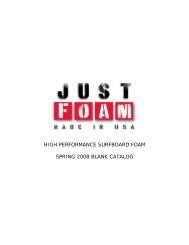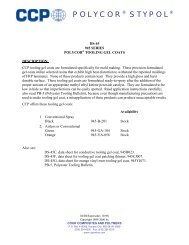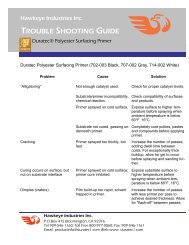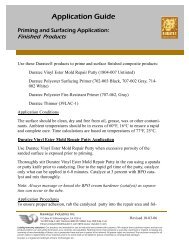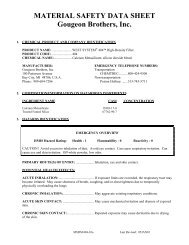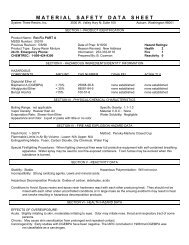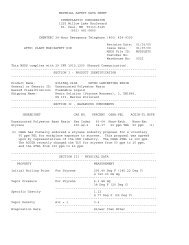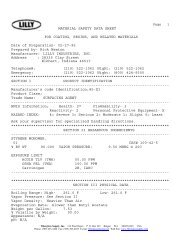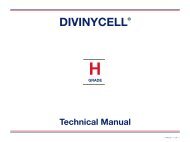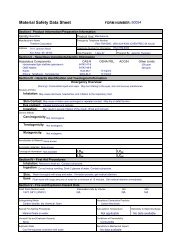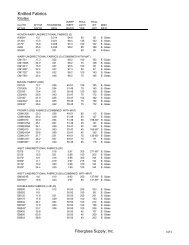MATERIAL SAFETY DATA SHEET - Fiberglass Supply
MATERIAL SAFETY DATA SHEET - Fiberglass Supply
MATERIAL SAFETY DATA SHEET - Fiberglass Supply
You also want an ePaper? Increase the reach of your titles
YUMPU automatically turns print PDFs into web optimized ePapers that Google loves.
<strong>MATERIAL</strong> <strong>SAFETY</strong> <strong>DATA</strong> <strong>SHEET</strong><br />
PHENOSET MICROSPHERES<br />
DATE OF ISSUE : 18 JUNE 2001<br />
MSDSUS Page 1 of 5<br />
1.0 IDENTIFICATION OF THE SUBSTANCE/PREPARATION AND OF THE COMPANY UNDERTAKING<br />
1.1 IDENTIFICATION OF THE SUBSTANCE<br />
CHEMICAL NAME<br />
CHEMICAL FAMILY<br />
FORMULA<br />
CAS AND NAME<br />
SYNONYMS, TRADE NAMES<br />
: Phenol formaldehyde resin<br />
: Phenolic resin<br />
: Not applicable<br />
: 9003-35-4 Phenol, polymer with formaldehyde<br />
: BJO-0930, BJO-0840, EPO-0360<br />
1.2 COMPANY IDENTIFICATION : MANUFACTURER<br />
ASIA PACIFIC MICROSPHERES SDN BHD<br />
NO 9, JALAN UTAS 15/7, 40200 SHAH ALAM Tel : 603-55181188<br />
SELANGOR DARUL EHSAN, MALAYSIA Fax : 603-55181122<br />
1.3 EMERGENCY TELEPHONE NUMBER<br />
603-55191801 OR 603-55181188<br />
2.0 COMPOSITION/INFORMATION ON INGREDIENTS<br />
INGREDIENT CONCENTRATION BY % WEIGHT HAZARD DANGER SYMBOL(S)<br />
Phenolic resin 100 See Section 3 None<br />
(CAS 9003-35-4)<br />
3.0 HAZARDS IDENTIFICATION<br />
3.1 HEALTH HAZARD <strong>DATA</strong><br />
3.1.1 EFFECTS OF A SINGLE EXPOSURE : Swallowing - No evidence of harmful effects from available information.<br />
: Skin absorption - No evidence of harmful effects from available information.<br />
: Inhalation - Short term harmful effects are not expected from vapour generated at<br />
ambient temperature.<br />
: Skin contact - No evidence of harmful effects from available information.<br />
: Eye contact - May cause irritation, experienced as stinging with excess blinking<br />
and<br />
tear production. Redness and swelling of the conjunctiva may occur.<br />
3.1.2 EFFECTS OF REPEATED EXPOSURE : This material may contain trace amount (
SWALLOWING<br />
INHALATION<br />
SKIN CONTACT<br />
EYE CONTACT<br />
NOTES TO PHYSICIAN<br />
: No emergency care anticipated.<br />
: No emergency care anticipated.<br />
: Remove contaminated clothing. Wash skin with soap and water. Obtain medical attention if<br />
irritation persists. Wash clothing before reuse.<br />
: Immediately flush eyes with water and continue washing several minutes. Obtain medical<br />
attention if discomfort persists.<br />
: There is no specific antidote. Treatment or overexposure should be directed at the control of<br />
symptoms and the clinical condition of the patient.<br />
5.0 FIRE-FIGHTING MEASURES<br />
5.1 EXTINGUISHING MEDIA<br />
Apply alcohol type or all purpose type foams by manufacturer’s recommended technique for large fires. Use carbon monoxide or dry<br />
chemical media for small fires.<br />
5.2 EXTINGUISHING MEDIA TO BE AVOIDED<br />
None<br />
5.3 SPECIAL FIRE FIGHTING PROCEDURES<br />
Do not direct a solid stream of water or foam into burning molten material; this may cause spattering and spread of fire.<br />
5.4 SPECIAL PROTECTIVE EQUIPMENT FOR FIRE FIGHTERS<br />
Use self-contained breathing apparatus and protective coating.<br />
5.5 UNUSUAL FIRE AND EXPLOSION HAZARDS<br />
Avoid dispersion of dust in air to reduce potential of dust ignition/explosions. Formaldehyde and phenol may form under fire conditions.<br />
6.0 ACCIDENTAL RELEASE MEASURE<br />
Wear suitable protective clothing. Collect for disposal.<br />
7.0 HANDLING AND STORAGE<br />
7.1 HANDLING<br />
7.1.1 GENERAL PRECAUTION : Avoid dispersion of dust in air.<br />
: Avoid sparks and flame under dust conditions.<br />
: Use with adequate ventilation.<br />
: Electrically bond and ground all equipment.<br />
: Avoid contact with skin. In case of contact with eyes, rinse immediately with plenty of<br />
water and call the physician if necessary.<br />
7.1.2 VENTILATION : Special, local ventilation is recommended in areas where containers are opened and<br />
their contents are discharged or in any other areas where dusting conditions may develop.<br />
7.1.3 OTHER PRECAUTION : [CAUTION] May undergo spontaneous smouldering if stored or heated in bulk<br />
above 35 C under conditions allowing air ingress to the product. Store package<br />
material in a cool, well ventilated area.<br />
: Do not store in the sun.<br />
: Do not dry in package - use special drying instructions as in 7.1.4.<br />
: Microspheres will undergo oxidation at elevated temperatures. Due to the microspheres’<br />
excellent insulating characteristics, the internal temperature of the mass can increase to the<br />
point where spontaneous ignition and smouldering can occur. The temperature at which this<br />
occur is a function of the geometry, amount of material being heated and available oxygen.<br />
Smouldering appears as a soft glow similar to burning charcoal.<br />
MSDSUS Page 3 of 5<br />
7.1.4 DRYING INSTRUCTIONS FOR : To reduce the moisture content of this product to less than 4%, dry a two inch<br />
THERMOSET MICROSPHERES<br />
layer or less of the product at a maximum temperature of 75 C for 24 hours. To
prevent oven or product contamination, the metal drying tray should be covered<br />
with a cloth that will allow the product moisture to evaporate. While handling the<br />
microspheres, precaution should be taken to prevent dispensing of the material in<br />
air to form dust. Any finely divided organic material dispersed in air can be ignited<br />
and under some condition develop into dust explosion.<br />
7.2 STORAGE<br />
Keep container closed.<br />
8.0 EXPOSURE CONTROLS AND PERSONAL PROTECTION<br />
8.1 EXPOSURE LIMIT<br />
No exposure limit has been established.<br />
8.2 PERSONAL PROTECTION<br />
8.2.1 RESPIRATORY PROTECTION : Dust respirator, if dusting condition exists.<br />
8.2.2 HAND PROTECTION/PROTECTIVE GLOVES : General working gloves are acceptable.<br />
8.2.3 EYE PROTECTION : Safety glasses.<br />
8.2.4 OTHER PROTECTIVE EQUIPMENT : Eye bath and safety shower.<br />
9.0 PHYSICAL AND CHEMICAL PROPERTIES<br />
PHYSICAL STATE<br />
: Hollow spheres<br />
COLOUR<br />
: Red brown<br />
ODOUR<br />
: No odour specified<br />
MOLECULAR WEIGHT : > 10,000<br />
BOILING POINT<br />
: Does not boil<br />
MELTING POINT<br />
: Does not melt<br />
AUTOIGNITIO TEMPERATURE<br />
: 160 ± 5 o C<br />
SPECIFIC GRAVITY (WATER = 1)<br />
: Not applicable<br />
SOLUBILITY IN WATER (BY % WEIGHT) : Not soluble<br />
PERCENTAGE VOLATILES<br />
: (maximum) 4 --- → water<br />
10.0 STABILITY AND REACTIVITY<br />
10.1 STABILITY<br />
10.1.1 GENERAL : Stable<br />
10.1.2 CONDITIONS TO AVOID : None known<br />
10.1.3 INCOMPATIBLE <strong>MATERIAL</strong>S : Strong oxidising agents<br />
: Strong acids<br />
: Strong alkalis<br />
: Halogens<br />
: Acyl halides<br />
10.1.4 HAZARDOUS COMBUSTION PRODUCTS : Burning or thermal decomposition can produce the following combustion or<br />
decomposition products :<br />
• Phenol<br />
• Formaldehyde<br />
• Carbon monoxide and/or carbon dioxide. Carbon monoxide is highly toxic if<br />
inhaled : carbon dioxide in sufficient concentration can act as an asphyxiant.<br />
MSDSUS Page 4 of 5<br />
10.2 POLYMERIZATION
10.2.1 GENERAL : Will not occur.<br />
10.2.2 CONDITIONS TO AVOID : None known.<br />
11.0 TOXICOLOGICAL INFORMATION<br />
11.1 ACUTE TOXICOLOGICAL INFORMATION<br />
All available information with relevance to human health hazard evaluation is indicated under Section 11.3<br />
11.2 SUB-ACUTE/SUB-CHRONIC/CHRONIC TOXICOLOGICAL INFORMATION<br />
All available information with relevance to human health hazard evaluation is indicated under Section 11.3<br />
11.3 SIGNIFICANT <strong>DATA</strong> WITH POSSIBLE RELEVANCE TO HUMAN HEALTH<br />
of<br />
Formaldehyde has been shown to cause cancer in laboratory animals and mutations in a variety of in-vitro test systems. The relevance<br />
these findings for human is unknown. Formaldehyde is listed as a carcinogen by IARC, NTP and OSHA.<br />
11.4 ADDITIONAL INFORMATION<br />
May cause skin and eyes irritation by contact.<br />
12.0 ECOLOGICAL INFORMATION<br />
12.1 PERSISTENCE AND DEGRADABILITY<br />
in<br />
All available ecological data have been taken into account for the development of the hazard and precautionary information contained<br />
this Safety Data Sheet.<br />
12.2 EFFECTS ON WASTE WATER TREATMENT SYSTEMS<br />
No information currently available.<br />
12.3 ENVIRONMENTAL RISKS<br />
in<br />
All available ecological data have been taken into account for the development of the hazard and precautionary information contained<br />
this Safety Data Sheet.<br />
13.0 DISPOSAL CONSIDERATIONS<br />
13.1 METHODS<br />
Incinerate in a furnace or otherwise dispose off in accordance with appropriate National and Local regulations.<br />
14.0 TRANSPORT INFORMATION<br />
14.1 TRANSPORT CLASSIFICATION<br />
ADR/RD<br />
MONT-BLANC<br />
IMDG<br />
MARPOL<br />
ICAO<br />
: This product is not submitted to the ADR regulations.<br />
: OK<br />
: This product is not submitted to the IMO regulations<br />
: ANNEX II - Not evaluated at this moment<br />
ANNEX III - Not classified<br />
: This product is not submitted to the ICAO regulations<br />
MSDSUS Page 5 of 5
15.0 REGULATORY INFORMATION<br />
The concentration shown are maximum or ceiling levels (weights %) to be used for calculations for regulations. Trade secrets are<br />
indicated<br />
by “TS”.<br />
15.1 FEDERAL EPA<br />
Comprehensive Environmental Response Concentration, and Liability Act of 1980 (CERCLA)<br />
requires notification of the National Response Center of release of quantities of Hazardous Substances equals to or greater than the<br />
reported quantities (RQs) in CFR 302.4<br />
(RQs)<br />
be<br />
Component in this product at a level which could require reporting under the statute are :None<br />
Superfunds Amendments and Reauthorisation Act of 1986 (SARA) Title III<br />
requires emergency planning based on threshold Planning Quantities (TPQs) and release reporting based on Reportable Quantities<br />
in 40 CFR 355 (used for SARA 02, 304, 311 and 312).<br />
Component in this product at a level which could require reporting under the statute are :None<br />
Superfunds Amendments and Reauthorisation Act of 1986 (SARA) Title III<br />
requires submission of annual reports of releases of toxic chemicals that appear in 40 CFR 372 (for SARA 313). This information must<br />
included in all MSDS that are copied and distributed for this material.<br />
Component in this product at a level which could require reporting under the statute are :None<br />
Toxic substance control Acts (TSCA) Status :<br />
The ingredients of this product are on the TSCA inventory.<br />
15.2 STATE RIGHT-TO-KNOW<br />
CALIFORNIA Proposition 65 This product contain trace quantities of formaldehyde, which in the State of California has<br />
found<br />
to cause cancer.<br />
MASSACHUSETTS<br />
Hazardous Substances and Extraordinarily Hazardous Substances on the MSL must be<br />
Right-to-know, Substance List identified when present in products.<br />
(MSL)<br />
Components present in this product at a level which could require reporting under the statute are :<br />
EXTRAORDINARILY HAZARDOUS SUBSTANCES (=>0.0001 %)<br />
CHEMICAL CAS NUMBER UPPER BOUND CONCENTRATION %<br />
Phenol 108-95-2- 0.01<br />
Formaldehyde 50-00-0 0.001<br />
PENNSLYVANIA<br />
Hazardous Substances and Special Hazardous Substances on the List must be identified<br />
when<br />
Right-to-know, Hazardous<br />
present in products.<br />
Substance List<br />
Components present in this product at a level which could require reporting under the statue are:<br />
SPECIAL HAZARDOUS SUBSTANCES (=.0.01 %)<br />
CHEMICAL CAS NUMBER UPPER BOUND CONCENTRATION %<br />
Phenol 108-95-2- 0.01<br />
CALIFORNIA SCAQMD RULE None<br />
443.1 VOC’S<br />
OTHER REGULATORY<br />
None<br />
INFORMATION<br />
16.0 OTHER INFORMATION<br />
16.1 RECOMMENDED USES AND : Please consult the product and/or applications information bulletins for this product.<br />
RESTRICTIONS<br />
16.2 REVISED SECTIONS IN THIS ISSUE : All sections in this issue have been revised
Note : The opinions expressed within this is current as of the date of this Material Safety Data Sheet. Since the use of this information and the<br />
conditions of the use of the product are not under the control of Asia Pacific Microspheres, it is the user’s obligation to determine conditions of<br />
safe use of the products.



